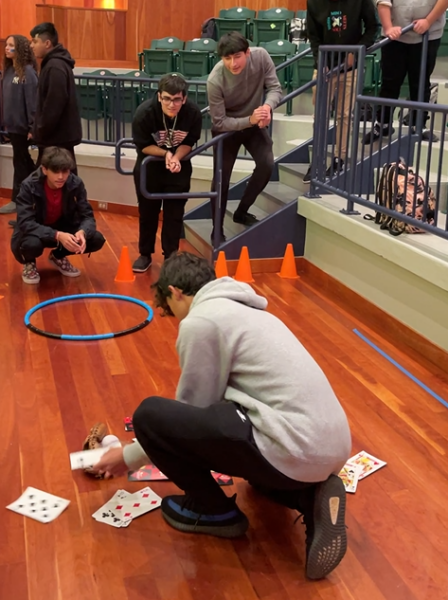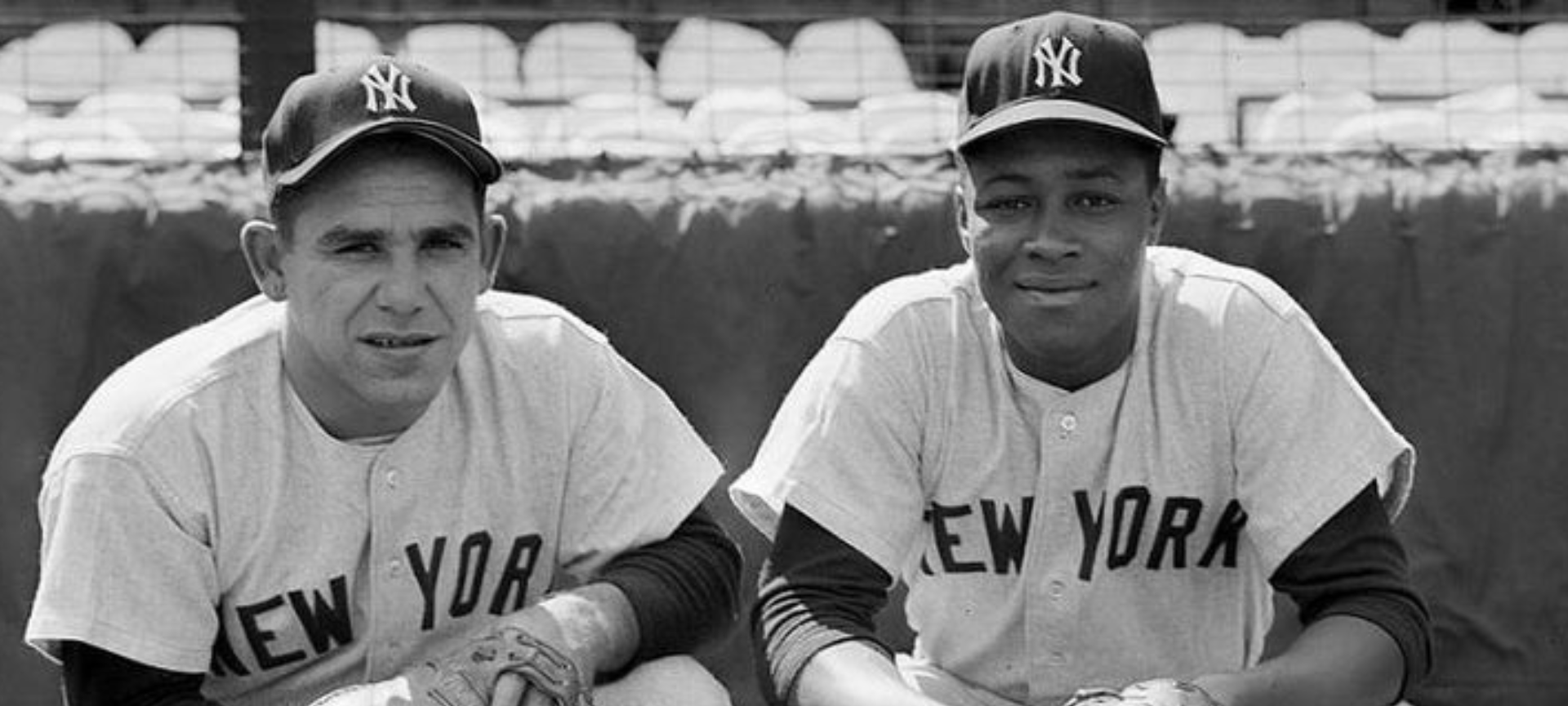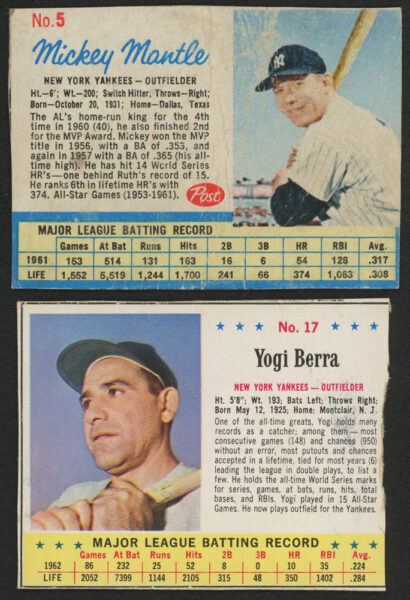Overwhelming Underdogs: Facing and Overcoming Obstacles
OVERVIEW
Students examine Yogi Berra’s life as the working class son of Italian immigrants who faced strong prejudice throughout his early life before finding success. Yogi experienced extensive verbal abuse for his heritage and “not looking like a baseball player.” This criticism shaped his character, honing his sense of fairness, and later prompting him to stand up for his good friend and fellow catcher, Elston Howard, the first Black New York Yankee who also experienced discrimination. Students find that Yogi Berra was just one of many “underdogs” throughout sports history.
VOCABULARY
Through hands-on activities and the use of technology, students will become familiar with the meanings of such words as Underdog, (& Overwhelming), Prejudice, Immigrant, Marginalized, Preconceived and Chauvinism.
OBJECTIVES
Students will:
- Work in teams, challenging themselves with fun physical obstacles;
- Watch sports footage and think critically about how athletes overcome adversity;
- Discuss Yogi’s famous “Yogi-isms”, their meanings and his playfulness with language;
- Learn about batting averages with real baseball cards, and consider what it means to fail at the plate 70% of the time, (a stat that applies only to excellent hitters!)
Part 1 – A Conversation: Being an Underdog and Overcoming Obstacles
Essential Questions:
- What does it mean to be an Underdog? In addition to Yogi Berra, can you think of other famous underdog examples from sports, movies or books?
- How can we overcome obstacles? How can we deal with prejudice?
- During World War II, women were the underdogs of baseball. Why and how did they get to play professionally?
- Nearly 60 years ago only 7% of high school girls played sports. What do you think is the percentage in your school today?
- What does it mean to stand up for someone who is an underdog? (Or someone who is “marginalized”?)
- What are the values Yogi Berra represents that help combat bullying or prejudice?
Part 2 – Discussion & Photo Gallery
Some famous sports underdogs include Yogi Berra, Jackie Robinson, Elston Howard, Billie Jean King and Steph Curry. What do you know about these athletes? What makes them underdogs?
Part 3 – Obstacle Box Activity

Students are divided into two teams. Each team of approximately 10 participants must complete each of EIGHT obstacles, ranging in difficulty. (Museum educators demonstrate obstacles, which are accessible to students of all abilities, age 8 and up.)
The obstacles are:
1) Do 8 jumping jacks
2) Hula hoop 8 rotations
3) Hop on one foot over an 8-foot long line of tape
4) Find all four 8’s in a giant pile of playing cards
5) Set giant dice in one of 3 possible sums of 8
6) Attach 8 rubber bands to a bat
7) One player puts on the catcher’s mitt and throws a ball to each other team member, completing at least (8 throws)
8) Answer one trivia question* from the hat as a team, high five your teacher, and sit down!
The first team to complete the Obstacle Box, high-five their teacher and sit, WINS!
Part 4 – Baseball Card Math
The Baseball Card Math activity begins with a short explanation of the fundamentals of BATTING AVERAGES. Each student is given an authentic souvenir baseball card dating from the 1960s to the present. We discuss player statistics and how baseball has its own language in terms of statistics.
Objectives:
Students will:
- Identify and understand the meaning of player statistics on baseball cards
- Recognize the use of whole numbers, decimals, fractions and probability in statistics
- Understand how math & probability are used in real world sports
Students are asked to assess batting averages in the context of character building, as indicators of success and failure. They consider the following:
An excellent hitter has a batting average of .300. That player hits the ball 30% of the time. What does that mean the batter is doing the other 70% of the time? What kinds of skills, characteristics and values might a player need to embody in order to deal with failing two-thirds of their at-bats? Students are encouraged to connect an ability to handle repeated failure with qualities such as self-confidence, perseverance, determination and optimism. This ability is an excellent example of overcoming obstacles.
BASEBALL CARD STATISTICS/KEY TERMS
- Batting Average, as represented by BA, AVG or PCT
- Hitting Probability/ Being “At Bat” or AB = The # of times you have the chance to hit the ball or are up at bat
- Games Played = G (# of games played)
- Hits = H (# of hits in a game or a season)
- Strikeouts = SO (# of times a batter strikes out)
Concluding Discussion Questions:
- What might change a player’s batting average?
- If a player has a batting average of .340, but regularly gets into fights with other players, is often in a bad mood, never cleans up after themself in the locker room, etc. Do you think that player will be hired over someone with a slightly lower batting average?
This program satisfies the NJ Department of Education requirements for the Diversity and Inclusion Law. Read more about this law here.
NJ STATE STANDARDS
MATH, GRADE 5
- Apply and extend previous understandings of multiplication and division.
- Interpret a fraction as division of the numerator by the denominator (a/b = a ÷ b).
- Solve word problems involving division of whole numbers leading to answers in the form of fractions or mixed numbers, e.g., by using visual fraction models or equations to represent the problem.
D1.2.3-5. ELA, GRADE 5
Identify disciplinary concepts and ideas associated with a compelling question that are open to different interpretations.
ELA-LITERACY.SL.9-10.1.C10. SPEAKING & LISTENING, GRADE 9 & 10
Propel conversations by posing and responding to questions that relate the current discussion to broader themes or larger ideas; actively incorporate others into the discussion; and clarify, verify, or challenge ideas and conclusions.


